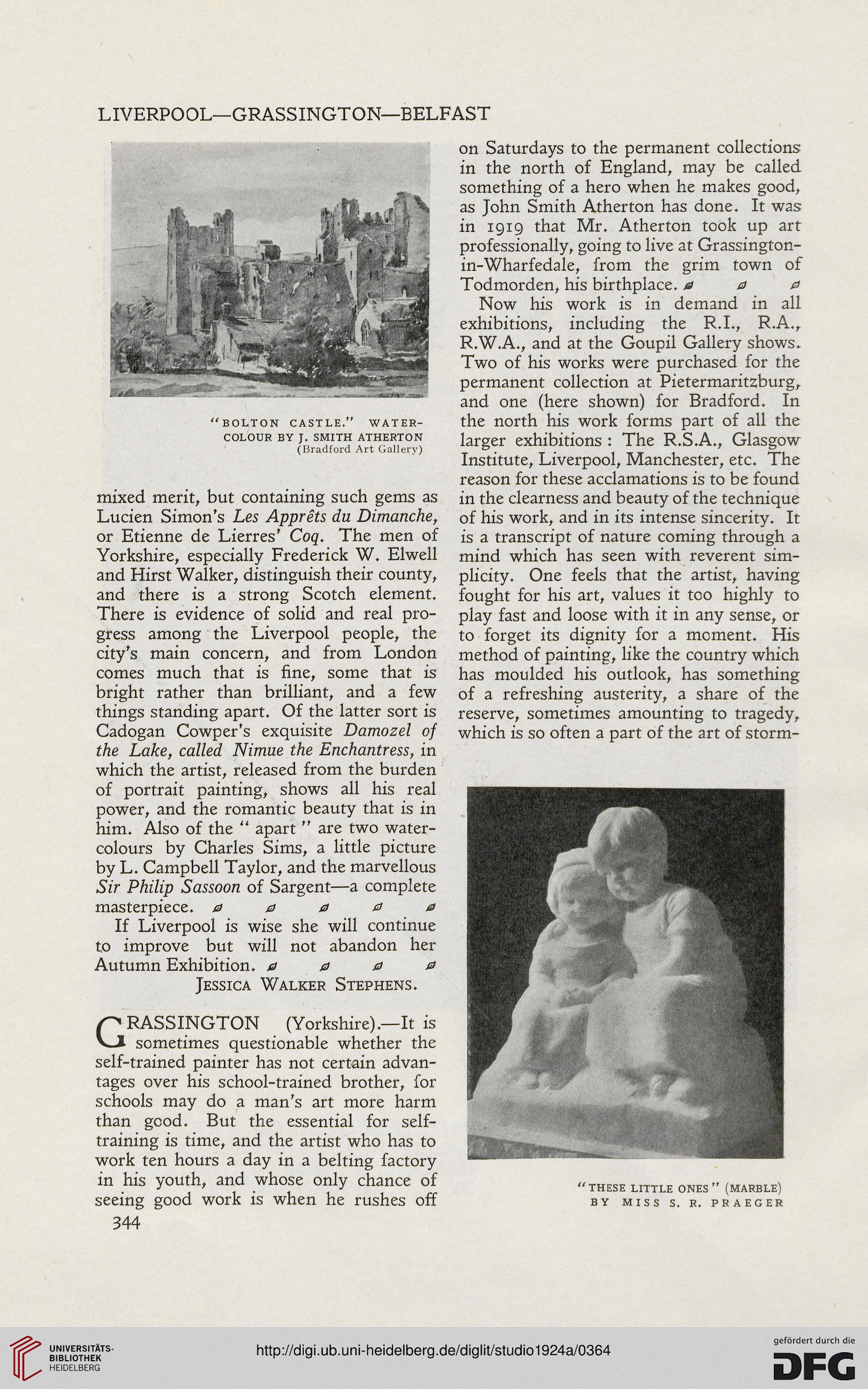LIVERPOOL—GRASSINGTON—BELFAST
"BOLTON CASTLE." WATER-
COLOUR BY J. SMITH ATHERTON
(Bradford Art Gallery)
mixed merit, but containing such gems as
Lucien Simon's Les Apprets du Dimanche,
or Etienne de Lierres' Coq. The men of
Yorkshire, especially Frederick W. Elwell
and Hirst Walker, distinguish their county,
and there is a strong Scotch element.
There is evidence of solid and real pro-
gress among the Liverpool people, the
city's main concern, and from London
comes much that is fine, some that is
bright rather than brilliant, and a few
things standing apart. Of the latter sort is
Cadogan Cowper's exquisite Damozel of
the Lake, called Nimue the Enchantress, in
which the artist, released from the burden
of portrait painting, shows all his real
power, and the romantic beauty that is in
him. Also of the " apart " are two water-
colours by Charles Sims, a little picture
by L. Campbell Taylor, and the marvellous
Sir Philip Sassoon of Sargent—a complete
masterpiece. 0000a
If Liverpool is wise she will continue
to improve but will not abandon her
Autumn Exhibition. 0000
Jessica Walker Stephens.
GRASSINGTON (Yorkshire).—It is
sometimes questionable whether the
self-trained painter has not certain advan-
tages over his school-trained brother, for
schools may do a man's art more harm
than good. But the essential for self-
training is time, and the artist who has to
work ten hours a day in a belting factory
in his youth, and whose only chance of
seeing good work is when he rushes off
344
on Saturdays to the permanent collections
in the north of England, may be called
something of a hero when he makes good,
as John Smith Atherton has done. It was
in 1919 that Mr. Atherton took up art
professionally, going to live at Grassington-
in-Wharfedale, from the grim town of
Todmorden, his birthplace. 000
Now his work is in demand in all
exhibitions, including the R.I., R.A.,
R.W.A., and at the Goupil Gallery shows.
Two of his works were purchased for the
permanent collection at Pietermaritzburg,
and one (here shown) for Bradford. In
the north his work forms part of all the
larger exhibitions : The R.S.A., Glasgow
Institute, Liverpool, Manchester, etc. The
reason for these acclamations is to be found
in the clearness and beauty of the technique
of his work, and in its intense sincerity. It
is a transcript of nature coming through a
mind which has seen with reverent sim-
plicity. One feels that the artist, having
fought for his art, values it too highly to
play fast and loose with it in any sense, or
to forget its dignity for a moment. His
method of painting, like the country which
has moulded his outlook, has something
of a refreshing austerity, a share of the
reserve, sometimes amounting to tragedy,
which is so often a part of the art of storm-
THESE LITTLE ONES " (MARBLE)
BY MISS S. R. PRAEGER
"BOLTON CASTLE." WATER-
COLOUR BY J. SMITH ATHERTON
(Bradford Art Gallery)
mixed merit, but containing such gems as
Lucien Simon's Les Apprets du Dimanche,
or Etienne de Lierres' Coq. The men of
Yorkshire, especially Frederick W. Elwell
and Hirst Walker, distinguish their county,
and there is a strong Scotch element.
There is evidence of solid and real pro-
gress among the Liverpool people, the
city's main concern, and from London
comes much that is fine, some that is
bright rather than brilliant, and a few
things standing apart. Of the latter sort is
Cadogan Cowper's exquisite Damozel of
the Lake, called Nimue the Enchantress, in
which the artist, released from the burden
of portrait painting, shows all his real
power, and the romantic beauty that is in
him. Also of the " apart " are two water-
colours by Charles Sims, a little picture
by L. Campbell Taylor, and the marvellous
Sir Philip Sassoon of Sargent—a complete
masterpiece. 0000a
If Liverpool is wise she will continue
to improve but will not abandon her
Autumn Exhibition. 0000
Jessica Walker Stephens.
GRASSINGTON (Yorkshire).—It is
sometimes questionable whether the
self-trained painter has not certain advan-
tages over his school-trained brother, for
schools may do a man's art more harm
than good. But the essential for self-
training is time, and the artist who has to
work ten hours a day in a belting factory
in his youth, and whose only chance of
seeing good work is when he rushes off
344
on Saturdays to the permanent collections
in the north of England, may be called
something of a hero when he makes good,
as John Smith Atherton has done. It was
in 1919 that Mr. Atherton took up art
professionally, going to live at Grassington-
in-Wharfedale, from the grim town of
Todmorden, his birthplace. 000
Now his work is in demand in all
exhibitions, including the R.I., R.A.,
R.W.A., and at the Goupil Gallery shows.
Two of his works were purchased for the
permanent collection at Pietermaritzburg,
and one (here shown) for Bradford. In
the north his work forms part of all the
larger exhibitions : The R.S.A., Glasgow
Institute, Liverpool, Manchester, etc. The
reason for these acclamations is to be found
in the clearness and beauty of the technique
of his work, and in its intense sincerity. It
is a transcript of nature coming through a
mind which has seen with reverent sim-
plicity. One feels that the artist, having
fought for his art, values it too highly to
play fast and loose with it in any sense, or
to forget its dignity for a moment. His
method of painting, like the country which
has moulded his outlook, has something
of a refreshing austerity, a share of the
reserve, sometimes amounting to tragedy,
which is so often a part of the art of storm-
THESE LITTLE ONES " (MARBLE)
BY MISS S. R. PRAEGER




